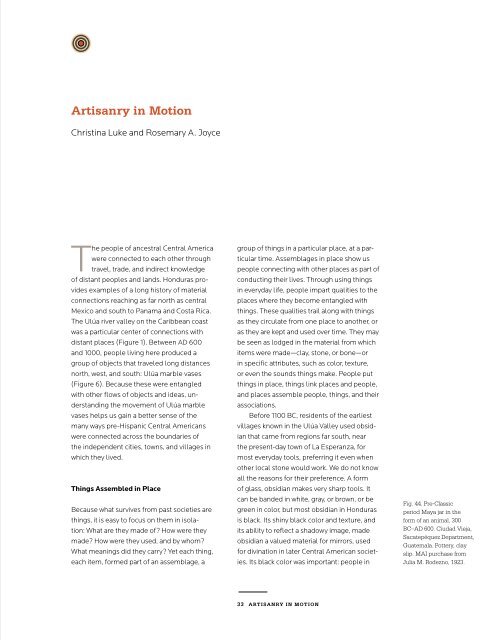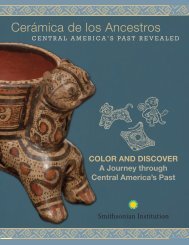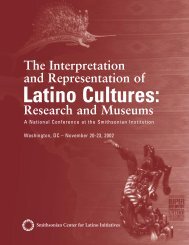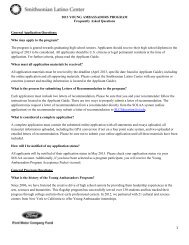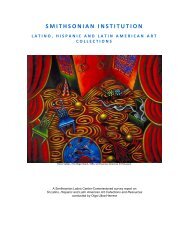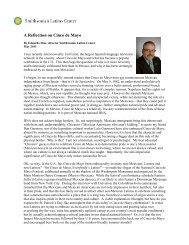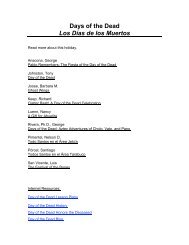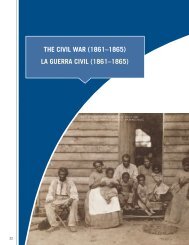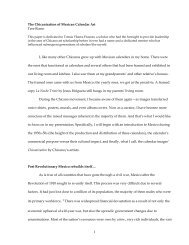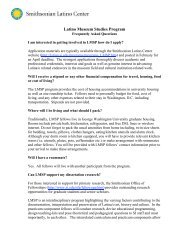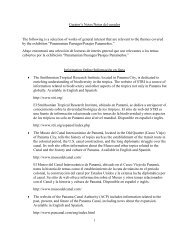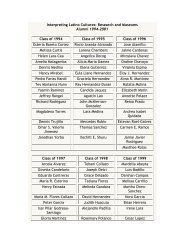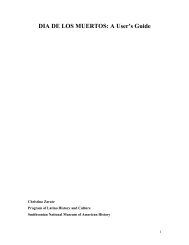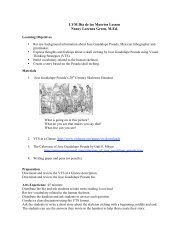Revealing Ancestral Central America - Smithsonian Latino Center ...
Revealing Ancestral Central America - Smithsonian Latino Center ...
Revealing Ancestral Central America - Smithsonian Latino Center ...
Create successful ePaper yourself
Turn your PDF publications into a flip-book with our unique Google optimized e-Paper software.
Artisanry in Motion<br />
Christina Luke and Rosemary A. Joyce<br />
The people of ancestral <strong>Central</strong> <strong>America</strong><br />
were connected to each other through<br />
travel, trade, and indirect knowledge<br />
of distant peoples and lands. Honduras provides<br />
examples of a long history of material<br />
connections reaching as far north as central<br />
Mexico and south to Panama and Costa Rica.<br />
The Ulúa river valley on the Caribbean coast<br />
was a particular center of connections with<br />
distant places (Figure 1). Between AD 600<br />
and 1000, people living here produced a<br />
group of objects that traveled long distances<br />
north, west, and south: Ulúa marble vases<br />
(Figure 6). Because these were entangled<br />
with other flows of objects and ideas, understanding<br />
the movement of Ulúa marble<br />
vases helps us gain a better sense of the<br />
many ways pre-Hispanic <strong>Central</strong> <strong>America</strong>ns<br />
were connected across the boundaries of<br />
the independent cities, towns, and villages in<br />
which they lived.<br />
Things Assembled in Place<br />
Because what survives from past societies are<br />
things, it is easy to focus on them in isolation:<br />
What are they made of How were they<br />
made How were they used, and by whom<br />
What meanings did they carry Yet each thing,<br />
each item, formed part of an assemblage, a<br />
group of things in a particular place, at a particular<br />
time. Assemblages in place show us<br />
people connecting with other places as part of<br />
conducting their lives. Through using things<br />
in everyday life, people impart qualities to the<br />
places where they become entangled with<br />
things. These qualities trail along with things<br />
as they circulate from one place to another, or<br />
as they are kept and used over time. They may<br />
be seen as lodged in the material from which<br />
items were made—clay, stone, or bone—or<br />
in specific attributes, such as color, texture,<br />
or even the sounds things make. People put<br />
things in place, things link places and people,<br />
and places assemble people, things, and their<br />
associations.<br />
Before 1100 BC, residents of the earliest<br />
villages known in the Ulúa Valley used obsidian<br />
that came from regions far south, near<br />
the present-day town of La Esperanza, for<br />
most everyday tools, preferring it even when<br />
other local stone would work. We do not know<br />
all the reasons for their preference. A form<br />
of glass, obsidian makes very sharp tools. It<br />
can be banded in white, gray, or brown, or be<br />
green in color, but most obsidian in Honduras<br />
is black. Its shiny black color and texture, and<br />
its ability to reflect a shadowy image, made<br />
obsidian a valued material for mirrors, used<br />
for divination in later <strong>Central</strong> <strong>America</strong>n societies.<br />
Its black color was important: people in<br />
Fig. 44. Pre-Classic<br />
period Maya jar in the<br />
form of an animal, 300<br />
BC–AD 600. Ciudad Vieja,<br />
Sacatepéquez Department,<br />
Guatemala. Pottery, clay<br />
slip. MAI purchase from<br />
Julia M. Rodezno, 1923.<br />
33 ARTISANRY IN MOTION


